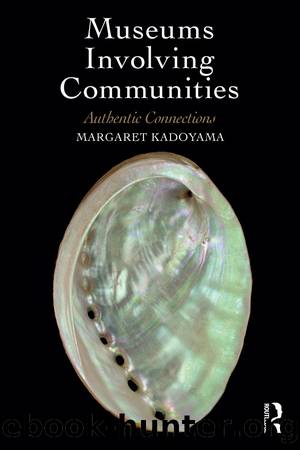Museums Involving Communities by Margaret Kadoyama

Author:Margaret Kadoyama [Kadoyama, Margaret]
Language: eng
Format: epub
Tags: Social Science, Archaeology
ISBN: 9781351203975
Google: 4HRUDwAAQBAJ
Publisher: Routledge
Published: 2018-02-02T03:34:13+00:00
Creating an Inclusive Work Environment
How can museum leadership and staff support people with valued skills after they are hired and working at a museum? As Jessica Turtle writes in Valuing Diversity: The Case for Inclusive Museums, for people who may identify as
⦠being of a diverse background, the day-to-day experience of working in museums can be exhausting and can present regular emotional and psychological challenges. This may lead to people leaving once they approach mid-career level, rather than continuing in a challenging landscape. In order to navigate organisational cultures, people report needing to: constantly articulate and demonstrate how they have achieved their position on merit; explain issues of identity and cultural heritage to colleagues and deal with micro-inequities on a daily basis. Micro-inequities occur as an effect of unconscious bias and can be defined as micro-messages that communicate who is âwithinâ and who is âwithoutâ. They are social and professional slights that can become collectively acted out without people realising. They have the effect of damaging morale and devaluing individuals. Although there have been some excellent entry route programmes to diversify the sector in recent years, there is anecdotal evidence that retention at mid-career level is an issue, due to the factors explored above.
Museums Association, 2016, p. 14
Turtle notes that
⦠research from the Equalities Challenge Unit demonstrates that unconscious bias not only impacts decisions related to recruitment and salary of individuals but also impacts investment in their ongoing development once inside an organisation.
Museums Association, 2016, p. 13
Whatâs especially important is the âeffect this has on day-to-day experience for those self-identifying as â or who are identified as â diverseâ (Museums Association, 2016, p. 13).
Gretchen Jennings, who writes the Museum Commons blog, has highlighted âThe Rule of Threeâ â the idea that when there are three or more people of diverse backgrounds in a group, the group culture begins to change â as a way to support staff of diverse backgrounds. She notes,
Just imagine what might happen if professional associations like AAM (including its Professional Networks), ASTC, ACM, AASLH, and various regional associations, our museums and other cultural organizations, our museum studies programs, etc. adopted The Rule of Three as an operative ideal for achieving institutional diversity and inclusion. Just think about the impact that three (or more) senior managers from underrepresented groups in our field might have on the organizational culture of our various institutions. Itâs not that three such people will think alike â far from it â but itâs likely that business as usual (some might call it white privilege*) will be disrupted. This may be why the idea is a bit discomfiting â but worth considering.
*â⦠invisible systems conferring dominance on my group ⦠an invisible package of assets that [white people] can count on cashing in each day ⦠Conditions that are viewed by whites as morally neutral. normative, and average, and also ideal, so that when we work to benefit others, this is seen as work that will allow them to be more like us.â Peggy Mcintosh.
Download
This site does not store any files on its server. We only index and link to content provided by other sites. Please contact the content providers to delete copyright contents if any and email us, we'll remove relevant links or contents immediately.
Adding Value to Policy Analysis and Advice by Claudia Scott; Karen Baehler(456)
Sociological Perspectives of Health and Illness by Constantinos N. Phellas(445)
Race and American Political Development by unknow(441)
American Government and Politics Today by Steffen W. Schmidt Mack C. Shelley Barbara A. Bardes(427)
Human and Global Security : An Exploration of Terms by Peter Stoett(425)
Control Of Oil - Hardback by Kayal(407)
Entrepreneurship Education and Training: The Issue of Effectiveness by Colette Henry Frances Hill Claire Leitch(368)
The Catholic Church and European State Formation, AD 1000-1500 by Jørgen Møller(356)
Materializing the Middle Passage by Jane Webster;(351)
The World According to China by Elizabeth C. Economy(344)
Left Is Not Woke by Susan Neiman(328)
Turkey's Relations with the West and the Turkic Republics: The Rise and Fall of the Turkish Model by Idris Bal(313)
Theories of Counseling and Psychotherapy: A Case Approach by Nancy L. Murdock(313)
Cross-Cultural Child Development for Social Workers by Lena Robinson(307)
Japan's Ainu Minority in Tokyo by Mark K. Watson(297)
Advances in Child Development and Behavior, Volume 37 by Patricia J. Bauer(295)
Laboratory Life by Bruno Latour(294)
Beyond Service: State Workers, Public Policy, and the Prospects for Democratic Administration by Greg McElligott(285)
The Oxford Handbook of Museum Archaeology by Stevenson Alice;(275)
